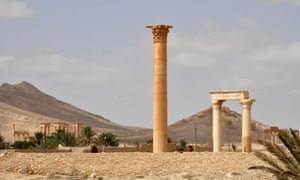
Antiquities experts watched nervously as Syrian government troops moved into Palmyra to recapture the ancient desert oasis from the Islamic State militant group. Their concern was that the fighting would cause deeper destruction to Palmyra’s archaeological ruins after Isis laid waste to some of the citadel’s most treasured artifacts.
But the first images to emerge from the city, known as the Venice of the Sands, suggest that while the damage is significant – and in many cases irreparable – their worst fears were not realized.
“What surprised us was that the damage was not worse,” said Amr al-Azm, a former Syrian antiquities official who is now a professor at Shawnee State University in Ohio.
“We had an idea of the damage and the scale of it even before the Syrian troops went in. What we were afraid of, and what was our biggest fear, was that the offensive would cause a lot of damage to the archaeological ruins as they tried to take the city back from Isis,” he said.
Syrian government troops seized the Unesco world heritage-listed citadel on Sunday, ending Isis’s bloody 10-month reign that saw executions staged in the historic Roman amphitheater and the destruction of some of the city’s most cherished monuments. With grand colonnaded streets rising from the desert sands, Palmyra was one of the world’s great historical landmarks. At the heart of Syrian lore is Zenobia, a third-century warrior-queen who led a rebellion against the city’s Roman overlords, and carved an independent state.
The city fell to Isis in May 2015. The extremist group destroyed the first-century Temple of Bel, which once stood among the best-preserved buildings in the city, and the triumphal arch that once stood at the head of a grand colonnade leading to the temple. Militants also beheaded 82-year-old Khaled al-Asaad, a renowned archaeologist and the head of antiquities for the ancient city of Palmyra, who apparently refused to reveal where valuable artifacts had been moved for safekeeping. “The destruction is part of a very skillfully propaganda campaign,” Al-Azm said. “The purpose of these atrocities is very simply to demonstrate Isis’s ability to act with impunity and the impotence of the international community to stop them.”
Al-Azm said he and other experts were mostly aware of the damage to the archeological site as they had been tracking the destruction through satellite imagery of the site and photographs taken surreptitiously by activists living there. However, he said he was only just now seeing the destruction to the inside of the Palmyra museum, which was transformed into a court by Isis.
Al-Azm said the museum appeared to have been ravaged by the militants, who destroyed dozens of artifacts before government troops expelled them from the city.
The advancing soldiers were warned to take care of mines and bombs planted by Isis that could wrought further damage to the site. Maamoun Abdelkarim, Syria’s current director of antiquities, told the Guardian in an interview over the weekend that once this process is complete, archeologists will be sent in to estimate the extent of the losses, and begin the long process of reconstructing the buildings from the rubble.
“It’s still early days,” Al-Azm said. “This is all going to take a long time.”
No comments:
Post a Comment